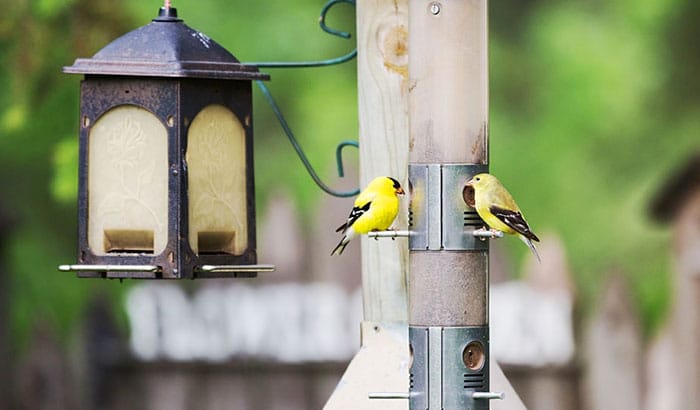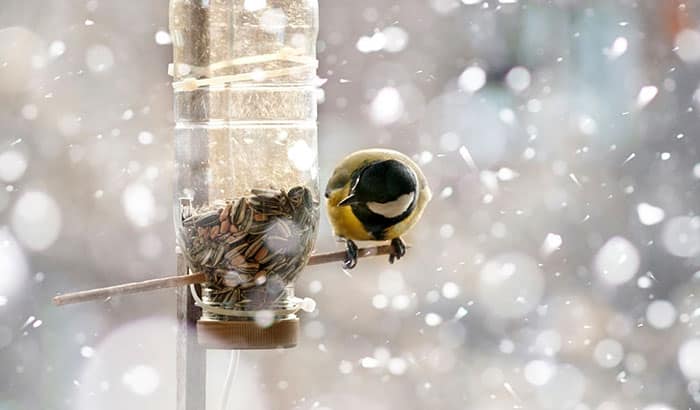Many newbie bird watchers find putting up new feeders distressing. Birds don’t immediately find the feeders. Many watchers begin to wonder, “How do birds find feeders?” The answer is quite simple, through their amazing senses, mostly using their powerful sense of sight.
I was disappointed when I first started hanging bird feeders in my yard only to discover the lack of birds flocking around them. I thought it was gonna be easy. Just hang a feeder and the birds will gratefully go to their new source of unlimited food. But it was not.
Understanding how birds behave when in search of food helped me better arrange my feeders for optimum bird presence.
Contents
Understanding Relevant Bird Facts
Bird Eyesight
After a bit of research, I discovered how birds in the wild search for food. Birds have a powerful sense of sight. Their sense of sight is so much more powerful than that of humans. They have a better perception and differentiation of colors. Though most of the time, this amazing sight is attributed to birds of prey, such as raptors, falcons, or hawks, all birds have better sight than us.
The simple truth is that flight demands perfect vision. It is necessary to have perfect depth, distance, and color perception. Humans have three types of photoreceptor cells. Each cell helps us identify the colors red, green, and blue (plus all of their combinations). Birds, however, have four photoreceptor cells. Aside from identifying colors, they are also sensitive to ultraviolet light.
Aside from their better color vision, birds also process movement better than humans. A large part of their brains is dedicated to processing visual information. They can detect rapid movement.
What do these scientific data have to do with how birds find feeders? Everything! I conducted an experiment of my own using the data I gathered. And I discovered a few unique methods of attracting more birds to my feeders.
Using color
With my knowledge about how good a bird’s color perception is, I incorporated colors into my feeder designs. I placed a few colorful plants and flowers around the feeder. I also tied a few colorful ribbons around the feeder. In just a few days, I saw an uptick in the number of birds visiting my yard.
Using movement
As I mentioned, I tied a few ribbons around my feeders. The ribbons sway and flail with the wind. And I believe this helped more birds find the feeder just beside the moving ribbons.
Bird Hearing
For birds, hearing is only second to vision in importance. As their sense of sight, avian hearing is better than that of humans. Studies confirm that birds, more specifically songbirds, hear more frequencies than humans.
Birds use their hearing for a variety of reasons. They use it to warn them of dangers or to find food. Perhaps the most common example of how well birds hear is the owl’s hunting method. Owls use auditory cues, or sounds, to hunt. However, other birds also use sound to detect sources of nourishment.
Though there are not a lot of scientific studies that support it, birds hear moving water. I did an experiment using this information. And the experiment went well. Just by adding a birdbath with a small fountain feature near my feeders, I observed a drastic improvement in the presence of birds.
Bird Communication
The sweet sounds I hear from birds are not for my benefit, I discovered. It is for their benefit as well as other bird. Birds use the sound they make to warn others of dangers, to scare off predators, to attract a mate, and to defend a territory. They also use their song to tell their kin about sources of food.
I discovered that avian communication helps birds find feeders. When a sparrow finds my feeder, I like to think that that little bird will tell all his friends about my feeder. Of course, there’s nothing much I can do about the fact that birds communicate. I can only make sure that my feeders are as accommodating to as many birds as possible.
With that in mind, I did more research that will help me make appealing feeders.
Dos and Don’ts of Feeders that Birds will Love
Don’t: Flavored Bird Feed
It is a popular myth that birds have a powerful sense of smell. It is also quite common among bird feed brands to advertise flavors as a way to attract more birds. The truth is, birds don’t use their senses of smell and taste as much. That is according to a study penned by Morley Kare of the University of Pennsylvania in 1970.
From their experiments, they discovered that birds are not attracted to different flavored seeds. They are also not too keen on how the seeds smell. What they are interested in is what the seeds or food look like. My experience taught me that birds generally prefer black seeds, like sunflower seeds, above all else. And science backs up my experience.
Do: Use Predator Deterrents
As I already explained above, birds hear and see well. They are extremely wary of danger. I make sure I hang my bird feeder high to discourage jumping animals. I also use baffles and other predator deterrents. If I’m hanging the feeder on a tree, I use a strong fishing line. A fishing line is too thin for rodents such as chipmunks or squirrels to navigate on. I also make sure that the feeder is far from the trunk because squirrels can jump horizontally to it.
Don’t: Play Sounds
While a recorded bird call may seem like a good idea, I discovered that it is not. Somehow, birds can detect that the sounds are not natural. I also discovered that they are not attracted to human music. The only sound I use to attract birds is the sound of moving water.
Do: Regularly Refill Seeds
Birds don’t like eating old or spoiled seeds (who would?). They will ignore dried seeds altogether. I find that only the blackest sunflower seeds attract them. If the seeds have a hint of brown, the birds don’t want them. Whatever seed I use, I make sure it is always fresh.
Don’t: Place the Bird Bath Too Near
Though bird baths can help attract more birds to my feeder, I also discovered that birds don’t like being disturbed when feasting. If the birdbath is too near the feeder, I noticed that there are fewer birds around the feeder. This is especially true during summer when there’s extra activity around the bath.
Final Thoughts
How do birds find feeders? Mainly with their powerful sight and hearing. Adding visual and auditory cues around feeders is helpful. They help attract more birds to the feeder. And with the right technique, they also make the backyard a lot more aesthetically pleasing.



Nice. Thank for sharing useful information. This article is so interesting for reading. Hope you write more.